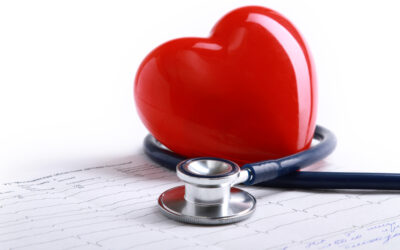

Are You Navigating the Symptoms of Perimenopause?

When I was in my mid-forties I started experiencing a number of seemingly unrelated symptoms – weight gain, brain fog, sore joints, and fatigue. I tried all sorts of one-off fixes – diets, exercise programs, and magic pills – without success. It wasn’t until my period started changing and I experienced hot flashes that the penny dropped and I connected everything to perimenopause. Did it happen like that for you too?
I wonder why there isn’t more talk about perimenopause? After all, it happens to all ladies, although it’s true that some have more challenges with it than others.
Perimenopause (and menopause) is the bookend to puberty, the reproductive part of our lives. So it includes a lot of hormone changes as the reproductive hormones – primarily estrogen and progesterone – naturally decline.
But the real challenge comes with how those changes impact our wellbeing. Like mood swings, inability to sleep, extreme fatigue, joint pain, digestive issues, hot flashes, night sweats, low sex drive and weight gain. What’s up with all that? Why can’t we just wind up our periods and call it a day?
There are two paths for getting help with perimenopause. The medical path and the lifestyle path. Unfortunately, many doctors are not well equipped to help. The American Association of Retired Persons reports most medical schools and residency programs don’t teach physicians in training about menopause. To make matters worse, a recent survey found that just 20% of ob-gyn residency programs provide any kind of menopause training.
When asked, 3 out of 4 ladies reported they did not get adequate treatment when they brought perimenopausal and menopausal concerns to their doctors. And 84% of women say their symptoms interfere with their lives and some are even debilitating.
One of the main areas where doctors should be able to help is in prescribing Hormone Replacement Therapy (HRT). Even though treatment has changed dramatically over the past decade, many doctors are unaware. The new body identical treatment is administered in patches or gel and poses none of the earlier health concerns for breast cancer and heart disease. The topical delivery method means that the liver is completely bypassed, and that absorption through the skin dramatically changes the health risks. Dr. Louise Newson, The Menopause Doctor, goes so far as to encourage women to consider taking body identical HRT for the protections it provides against heart disease, osteoporosis, diabetes and Alzheimer’s.
The other path to get help with the symptoms of perimenopause is through lifestyle. There is a lot that lifestyle habits and behaviors can do to demystify the changes. It turns out the healthy practices of diet and exercise that ladies maintained before perimenopause are unlikely to suit them very well once they enter perimenopause. As our nutrition needs change, so does our digestion. We no longer need all the protein we used to eat, and our sensitivity to sugar and processed foods heightens. Bloating, brain fog, joint pain and weight gain result.
And with hormonal changes to our muscles and joints, the type of exercise and movement that is beneficial also changes. Even if you have always been athletically active, the fatigue and joint pain can make ambitious workouts very difficult. In fact, high impact and anaerobic exercise can cause stress to the system and result in the production of cortisol, the stress hormone. The timing and type of movement you choose take on new importance.
Hormonal changes impact sleep, especially when combined with food choices and stress. So figuring out new sleep hygiene habits are vital to being able to restore the body each night with quality sleep. As we sleep, the body is busy removing dead cells burning fat and rebuilding tissue. The brain catalogues the day’s experiences and builds up memories. Without adequate sleep, the body is stressed when it cannot carry out these maintenance functions and produces cortisol in response. That in turn stimulates appetite, which produces more insulin leading to fat production (and stubbornly stored around the middle). So getting enough good sleep is vital to being able to adapt through the changes of perimenopause.
And finally, mindfulness – getting your head in the game is so important. As it happens, the mind can only focus on one thing at a time. So if you control some of the things you tell yourself and make them positive things, you will benefit from that. Rather than tell yourself that you’re a lazy slob or beat yourself up because you don’t have enough willpower, you tell yourself that you’re an intelligent woman and the goal is achievable. Meditation is a great way to calm the mind, focus on positive things and create endorphins. This can really help to create positivity, reduce cortisol levels and help with sleep.
Are you satisfied with the support your doctor has been giving you for the symptoms of perimenopause? Some symptoms are best resolved using HRT. But many more can be resolved by taking a lifestyle approach.
The beginning of my perimenopausal journey didn’t go well, and I’m determined to help ladies navigate this chapter of their lives so they can take control of the next decades and live their best lives.
To find out how you can navigate the symptoms of perimenopause, click the button to book your free call with Dyna Vink, Health and Nutritional Coach.
5 Health Risks in Perimenopause and Beyond

Even women who have had no health issues before perimenopause can face increased odds of problems after going through the transition into menopause. In addition to the loss of estrogen, other shifts happen in the body that can harm your health after menopause. For example, blood pressure, LDL (“bad”) cholesterol, and triglycerides tend to increase after menopause, according to the American Heart Association (AHA), although they are unsure why.
These are the 5 most common health conditions that can have an increased risk after menopause.
Heart disease
Osteoporosis
Weight gain
Breast cancer
Incontinence
1. Heart Disease
Nearly a third of women develop cardiovascular disease, the AHA says, and the rate of heart attacks in women begins increasing roughly a decade after menopause. A key reason is that estrogen helps keep blood vessels flexible, so they contract and expand to accommodate blood flow. Once estrogen diminishes, this benefit is lost. Coupled with other changes, such as the rise in blood pressure that can thicken artery walls, women’s hearts suddenly become vulnerable.
A study in the Journal of the American Heart Association (Feb 2021) found that frequent and persistent hot flashes were associated with future cardiovascular disease. In particular, women who have a family history of heart disease combined with significant hot flashes should ask their healthcare provider if they need additional screenings for cardiovascular disease.
Of course, you cannot control your family history, which influences your risk, but you can lower your overall risk by following a heart-healthy lifestyle. This includes eating a diet with lots of vegetables and low in sugar, exercising for 150 minutes or more each week, and not smoking.
2. Osteoporosis
Women are 4 times as likely as men to develop osteoporosis, a disease in which bones become thin and weak and fracture more easily. Before menopause, women’s bones are protected by estrogen, but in the year before the final menstrual period and continuing for about three years after, bone loss can be fast. You may not even notice that your bones are weakening, as osteoporosis may not cause symptoms for decades. A bone fracture can be the first sign of the disease.
To keep your bones strong, use lifestyle approaches such as movement and food choices. Do weight-bearing exercises, such as brisk walking and light weights, because they allow your bones to work against gravity to get stronger. Choose foods high in vitamin D — or 15 minutes of sun exposure several days a week — and calcium (dark leafy greens, and canned fish such as salmon and sardines).
3. Weight Gain
Menopause has a definite effect on a woman’s metabolism. Menopause causes your body to gain fat and lose lean tissue mass approximately two years before your last menstrual period until two years into your postmenopausal period. And this is a problem. Because excess weight, especially around the abdomen, can boost your risk of type 2 diabetes and puts you at greater risk of heart disease.
Unfortunately, menopause is linked to an increased risk for metabolic syndrome — a collection of health conditions including high blood pressure, high blood sugar, excess abdominal fat, and abnormal cholesterol levels – that increase your risk for heart disease, stroke, and type 2 diabetes (September 2020, Menopause).
The reason for this increased risk of abdominal fat is because of lower estrogen levels, which shifts fat from the hips to the midsection. Women in perimenopause who have sleep problems, night sweats, and mood issues often find these symptoms interfere with eating a hormone healthy diet or exercising.
Cutting back on food can help. Eating your biggest meal at noon is a great tip – avoid snacking. And keeping a positive mindset with mindful meditation or yoga to help to shed weight and be positive.
4. Breast Cancer
The risks of breast cancer during and after menopause are increased by excess weight, smoking, alcohol, lack of exercise and poor food choices. The change in hormones leaves the body vulnerable to cancer and if these other factors are at play, the risk of contracting cancer increases. Hereditary factors also play a role.
To reduce the risk of breast cancer, it’s recommended to have a health weight, enjoy regular exercise, eat hormone healthy food, limit alcohol and do not smoke. There is also a link between cancer and synthetic hormone replacement therapy (HRT). But the newer body identical varieties have far fewer problems, except for women with estrogen related conditions.
5. Urinary Incontinence
Difficulty controlling the bladder can begin in perimenopause and continue for years after. Approximately half of postmenopausal women experience urinary incontinence. The most common type is stress urinary incontinence, where coughing, sneezing, or physical activity causes leakage. Urgency incontinence is when leakage is accompanied by an uncontrollable urge to get to the bathroom immediately. Many women have a mix of the two.
The tissues of the bladder and urethra contain estrogen and progesterone receptors and are thickened by those hormones. After menopause, these hormone levels drop, and the tissue thins and weakens. In addition, the muscles around the pelvis may lose tone with aging, which is a process known as “pelvic relaxation.”
The pelvic floor has 3 layers of muscles. For one of the layers it helps to do Kegel exercises, contracting and relaxing the muscles of the pelvic floor. The key to proper Kegels is to work the subtle muscles controlling the stream of urine, rather than the butt muscles. Hold each contraction for two to three seconds, building up to five sets of 10 repetitions per day. If problems persist, seek a physical therapist with expertise in working the pelvic floor.
#lifestyleapproach #perimenopause #menopause #sleepwell #wellness #holistichealth

Holistic Nutrition Lifestyle | Copyright © 2025 | All Rights Reserved
“This site is not a part of the Facebook website or Facebook Inc. Additionally, this site is NOT
endorsed by Facebook in any way.
FACEBOOK is a trademark of FACEBOOK, Inc.”